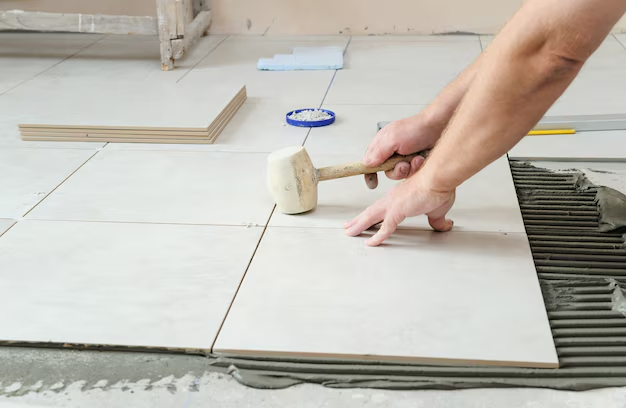The Role of Tile Adhesive in Seismic Zones: Flexibility and Crack Resistance
Yes. The failure of tiles is common in seismic areas since the traditional cement mortar is not able to withstand the movements of the ground. Modern tile adhesive, particularly Polymer tile adhesive and PU based adhesive, is flexible and crack resistant, which guarantees that tiles remain in place during tremors.
Introduction
Special consideration of construction is required in earthquake-prone areas. Most of the discussions are centered on the building design and reinforcement; however, one of the aspects that is not usually considered is the material that holds the tiles. In seismic areas, weaker bonding causes tiles to pop up, crack, or fall off, which is unsafe since they are used as decorative features as well as areas of protection.
Conventional cement-sand mortar is too stiff to take up seismic vibrations. This inflexibility leads to shear stress between the tile and the substrate and leads to detachment. The solution is modern tile adhesives that are developed to resist structural movement, cracking, and strong bonding in harsh environments.
At Redwop, advanced formulations such as polymer-modified tile adhesive, Epoxy-based tile adhesive, and PU-based adhesive are specifically engineered to meet these challenges.
Why Tiles Fail in Seismic Zones
During earthquakes, tiles can fail because of many factors:
- Rigid Mortar Bonds – Traditional mortar cannot handle lateral or vertical ground shifts.
- Shear Stress – Movement between tiles and substrate causes cracks.
- Vibration Impact – Continuous micro-vibrations weaken adhesion over time.
- Thermal Expansion & Contraction – Structural stress adds to seismic impact.
When these factors combine, tiles pop off or crack, leading to costly repairs and safety concerns.
How Tile Adhesive Solves Seismic Challenges
1. Flexibility Under Stress
Polymer-modified tile adhesive is flexible in nature, unlike rigid mortar, which enables the tiles to shift slightly with the surface without breaking. This is a property that is essential in the seismic-prone areas where buildings keep vibrating.
2. Crack Resistance
Modern adhesives form a strong bond that resists cracking caused by shear stress. By distributing load evenly across the tile surface, they prevent localized stress points that typically lead to breakage.
3. Strong and Durable Bonding
High-performance adhesives like polymer tile adhesive and PU-based adhesive create long-lasting bonds that reduce the risk of tiles detaching during tremors.
4. Suitable for Multiple Applications
- Polymer Modified Adhesives – Best for floors and walls in residential and commercial buildings.
- PU-Based Adhesives – Ideal for external façades and cladding where flexibility and weather resistance are critical.
Redwop Solutions for Seismic Zones
- Polymer Tile Adhesive – Perfect for areas where flexibility and strength are required. It is recommended for vitrified, porcelain, and natural stone tiles in seismic-prone structures. Explore Redwop’s Polymer Tile Adhesive to ensure long-lasting tile performance.
- Epoxy-based tile adhesive– Designed for high-strength installation of ceramic, porcelain, glass, and natural stone tiles. It offers exceptional adhesion, chemical resistance, and water impermeability, making it ideal for areas exposed to moisture, heavy traffic, or aggressive cleaning agents such as commercial kitchens, swimming pools, and industrial floors. Learn more about Redwop’s Epoxy-based tile adhesive.
- PU-Based Adhesive – Engineered for extreme flexibility, this adhesive absorbs vibrations and thermal expansion. It is ideal for external wall cladding and façades exposed to seismic forces. Learn more about Redwop’s PU-Based Adhesive for earthquake-resistant construction.
Applications in Seismic-Prone Projects
- Residential Housing – Safer homes with less risk of falling tiles.
- High-Rise Buildings – The adhesives are used to secure the facades and external cladding against vibration.
- Commercial Complexes – The strong bonding ensures durability in high-traffic areas.
- Public Infrastructure – These include schools, hospitals, and transit hubs where high safety is required.
Best Practices for Installation in Seismic Zones
These are professional tips to maximize performance:
- The adhesive should be applied to a clean and level surface.
- Apply the correct type of adhesive to the tile size and use.
- Apply adhesive with a notched trowel for uniform coverage.
- Use back-buttering for large or heavy tiles.
- Provide expansion joints to handle movement safely.
Advantages of Using Tile Adhesives in Seismic Areas
- Flexibility – Absorbs ground movement without cracking.
- Crack Resistance – Minimizes shear stress and tile breakages.
- Durability – A good adhesive maintains durability.
- Safety – Prevents falling tiles in case of tremors.
- Versatility– Suitable for the flooring and walls, and also on external facades.
Conclusion
In seismic zones, using the right tile adhesive is not just about aesthetics — it’s about safety and durability. Although the conventional mortar collapses when these forces are applied to it, new technologies such as polymer-modified tile adhesive, Epoxy-based adhesive, and PU-based adhesive allow the material to be flexible and tough enough to survive the seismic forces.
When you select the appropriate Redwop adhesive, you are guaranteed a secure layer on your tiles, safe spaces, and a longer structural life.
For expert guidance on selecting the right adhesive for your project, Contact Redwop here.
FAQs
-
1. Why are tiles more unsafe in seismic zones?
Tiles attached using traditional mortar are hard and cannot resist any vibrations or movement of the ground, which causes cracks and pop-offs.
-
2. Which is the best tile adhesive for earthquake-prone areas?
Polymer-modified tile adhesive is most suitable for allowing flexibility, and PU-based adhesive and epoxy-based tile adhesive are most suitable for facades and exterior use.
-
3. Can tile adhesives completely prevent cracks in seismic areas?
Although no material can protect the structure against earthquakes, quality adhesives can help to decrease the risk of cracking and detachment
-
4. Is polymer tile adhesive suitable for heavy flooring?
Yes, it provides excellent bonding strength for vitrified and porcelain tiles, even in high-load areas.
-
5. How does PU-based adhesive help in seismic construction?
Its flexibility absorbs vibrations and thermal movement, making it perfect for external walls and cladding.



